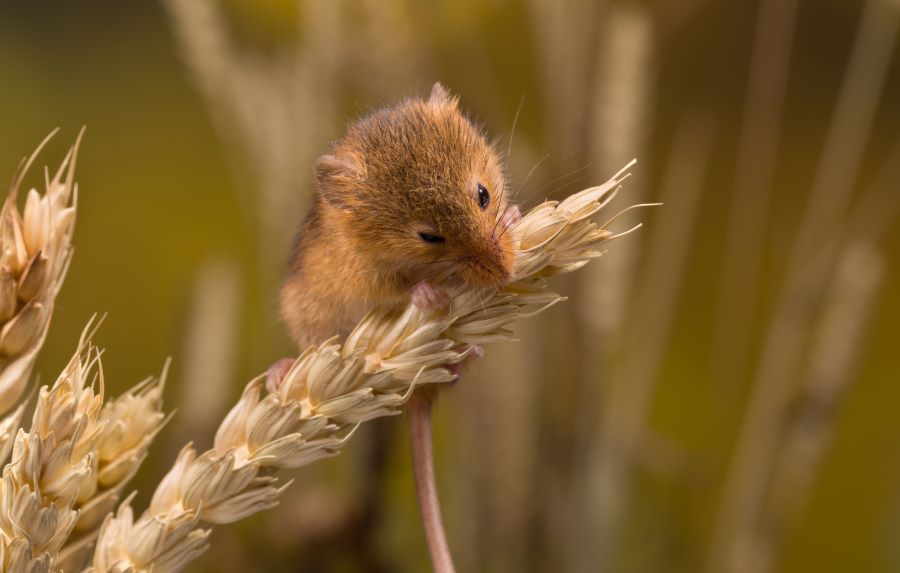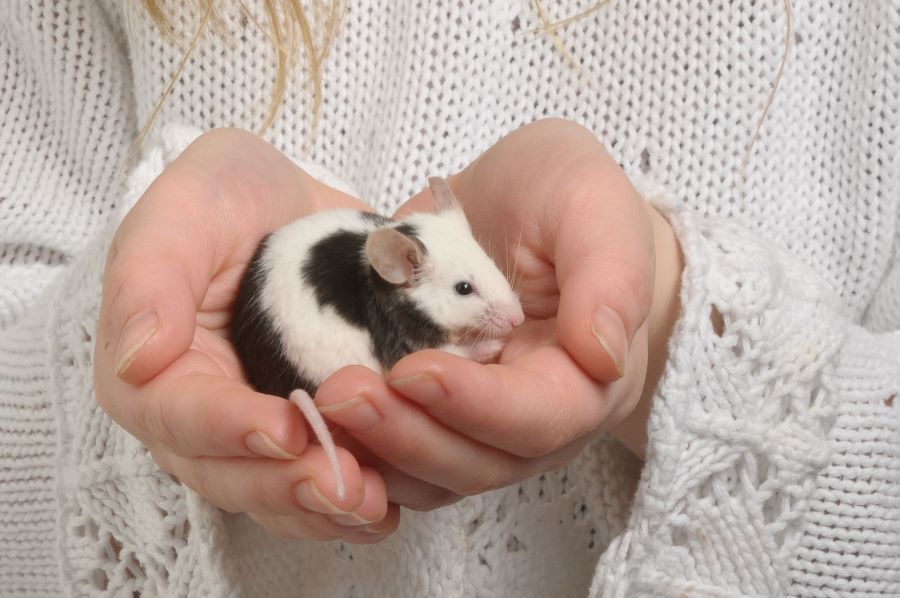Some of the posts on Mercury Pets contain affiliate links to products. That means if you click on that link and then make a purchase, we receive a percentage of the sale. We only recommend products we’ve used and support, and there’s no additional cost to you — the money goes right back into making this site the best it can be! Thanks for reading.

Most people are aware that mice have quite a varied diet. But are mice going to eat plants? Well, the answer is a resounding yes.
Mice love eating plants, and they enjoy eating a wide range of many varieties of both house and garden plants. They enjoy greens, flowers, and a wide range of leaves.
To be honest it’s more a case of wondering which plants they would not go ahead and eat. You see, mice love to nibble, and they like their greens when it comes to their food. However, they need to be mixed in with some veggies, as well as grains and seeds to provide them with a balanced diet.
I have 12 facts to share with you about mice eating plants.
So, what are the types of things you should know?
Well, it’s not a simple case of seeing a plant and thinking a mouse will love eating it. In fact, they are a bit more selective regarding what they will consume than most people are aware. People think a mouse will chomp away on anything you throw at them, but their digestive systems are not made that way.
So, let’s find out the ultimate 12 facts it’s important to know about mice eating plants.
1. They Love Plants – Both Garden and Houseplants
The first thing to know is that a mouse is going to eat almost any sort of plant. They love both garden and houseplants, as they see them all as being a wonderful source of food.
As a note, even though we said they will eat almost ‘any sort of plant’ does not mean they will. They instinctively know which plants are there for eating, and those that are not due to them being toxic. So, certain plants will be able to repel mice rather than attract them.
Also, there are some plants that will have a tendency to really attract mice, as they see them as some form of delicacy. So, if you have mice as pets, then you may want to consider giving them a selection of plants as part of their diet.
But at the same time, some plants are not going to be viewed in such a positive light by your pet mice. In fact, some are going to repulse them and possibly be toxic. So, being aware of what is good for your pet mouse is clearly important.
Please do not think you can simply feed anything you want to them. That’s not going to go work. In fact, you could make matters worse if you believe they can eat anything that is green in color.
2. Leafy Vegetables are Best
Giving your pet mice some leafy green vegetables will work out best for them. Basically, anything along the lines of lettuce, kale, cabbage, cucumber, even carrots will go down well with them. Also, they will eat the stalks, so don’t go chopping those off in order to try to make things look nice.
If you plan on giving them some veggies, then introduce one or two at a time. Don’t create some veggie salad for them and throw it all into their cage. Try them out with a small amount of each one independently to help learn as to the likes and dislikes of your own pet mice.
One other tip when it comes to leafy vegetables. Your bet mouse will chomp away on any part of it. That means the carrot itself will only be part of their meal. The stalks at the top are also going to be enjoyed.
3. Flowers are Also a Treat
Your pet mice will also love some flowers to nibble on, and it does appear to be the case that they have their favorites. Flowers such as tulips and crocus are high on their list of things they want to eat, while iris and hyacinth will also prove to be rather popular.
It’s not just the petals they eat either. They love the stalks and stems, so if you have any of those plants in your garden, then cut some down and add them to their cage. They will see this as a real delicacy, and will nibble away without a care in the world.
4. Not All Plants are Edible
However, even though the list of plants that mice can eat is rather extensive, that doesn’t mean they can eat any plant. Actually, there are a number of plants that will turn out to be toxic for your pet mice, so under no circumstances should you seek to feed them to a mouse.
Plants such as daffodil bulbs and snowdrop bulbs are not a good idea.
You should also note that a mouse is not going to enjoy eating catnip. That sort of thing repulses them, so keep it away from your mouse, and they will be very happy with you.
You should also avoid giving your mouse the leaves from an azalea, as an example. Ivy and foxglove are another couple of examples of plants that are toxic to mice.
Of course, that does also mean they will be safe in your garden, so if you are fed up with wild rodents digging up your garden and destroying your plants, then sticking with those that are known to be toxic to them will work wonders.
5. Be Careful with Fruit
While you may think fruit would be a wonderful treat for your pet mice, that will only be the case with certain fruits. Others should be avoided at all costs.
The main ones to avoid feeding to a mouse does tend to focus on any that fall within the citrus family. That means any sort of oranges, lemons, and grapefruit.
However, if you want to feed a mouse some fruit, then chop up a bit of apple, pear, peach, or even a small part of melon. They have more of a delicate taste and will be easier for your pet mouse to digest it without running into problems.
6. A Mouse Won’t Enjoy Herbs
If you think that herbs will be tasty to a pet mouse, then you would be wrong. Most herbs are not going to be enjoyable to a mouse, as they are simply too strong when it comes to their taste. Mint and lavender are not going to go down too well at all, so avoid giving them to your mouse all chopped up thinking you are adding variety.
On the flip side, if you are having a problem with wild mice in your garden, then including various herbs will at least mean they should be safe from being destroyed by mice.
You should also know that onions and garlic will not be an enjoyable treat for your pet mice. Once again, the smell and taste will be too overpowering for them, and that’s going to repel them.
For herbs, you can feed some of them to your pet mice. However, they need to be on the milder side, so the likes of Parsley will go down well. Avoid chives, as they have that onion flavor to them, and that’s not going to sit well with your pet mouse.

7. They Do Prefer Seeds and Grains
Even though we are talking about plants, you should be aware that mice will prefer to eat seeds and grains. However, that’s also why they enjoy sunflowers so much. They are able to get the best of both worlds at the same time.
With plants such as sunflowers, they will be able to chomp away on the foliage while also indulging in seeds later on. So, if you want to give your pet mouse a great meal, then some sunflower leaves and seeds will be greatly appreciated by them.
8. Feeding Your Pet Mice
So, what is the best way to feed your pet mice? Well, if you are feeding them seeds and grains, then scatter them around their home to make them go out and search for them. This makes it more fun for your mouse, and it does replicate what’s going to happen in the wild.
Of course, that’s tougher when feeding them leaves or parts of veggies. Also, you don’t need to chop things up into small pieces to make it easier for them. They have sharp enough teeth to go ahead and munch away. After all, that’s how they would deal with it in the wild.
9. Variety is Best
One of the main things you need to remember with feeding your pet mouse is that they do require variety. You must look at providing them with quite a broad spectrum of food to help keep them in tip top shape. [Source]
But always do this in small quantities, and don’t go chopping and changing everything at the one time. That’s not going to bode well for them, because even though they like variety, they are not that keen on too much change at the one time.
10. How Much, and How Often?
You need to feed your pet mice a small quantity of food each day. Remember that they have a very small stomach, so you don’t need to have piles of plants or seeds sitting in their cage. [Source]
But you should also have some plants sitting there for them to nibble on throughout the day. This will allow them to go back and forth as they want, and whenever they feel a bit on the peckish side.
11. Don’t Forget Some Softwood
So this may not be the leafy part of plants, but you should also provide your pet mice with some softwood to nibble on. This will be good for their teeth, but you also need to be careful as to what you feed them.
In general, you should be looking at leaving them some wood from apple trees, pear, hawthorn, and even willow. However, if you want to do this for them, then you cannot simply throw in the wood and let them get on with it.
Instead, it’s better to cut it up into pieces and then bake it in your oven on a low heat for an hour. This will help make it completely safe for your pet mouse, but just watch that you don’t burn it as that’s not going to help them at all.
12. Don’t Suddenly Change Their Diet
One other important point to make is that you cannot go ahead and change their diet in an instant. That sort of thing will upset their stomach and could make them ill.
It turns out that the digestive system of a mouse is quite a delicate thing. On the flip side, it does show how important it is for you to be aware of what you are feeding them. The plants and items we have mentioned above that should be avoided may not all be toxic to a mouse, but it will certainly be bad for their digestion if you feed it to them.
Final Thoughts
So, as you can see, there is a rather long list of things you can feed your pet mice. As a result, they should never be in a position where there’s nothing to eat for them.
Your main focus should be on double-checking that you are not giving them anything that is going to be bad for their health. Plants such as daffodils may look as if they would be a great snack for a mouse, but that’s not the case.
Remember to feed them a small amount at a time, and do so daily. Keep their water supply topped up and ready for them to drink by switching it out for fresh stuff every single day.
Overall, just spend time watching your pet mice nibbling away on their assortment of plants, fruit, and seeds. It’s amazing how much fun it can end up being.



